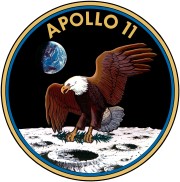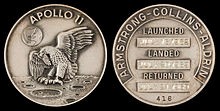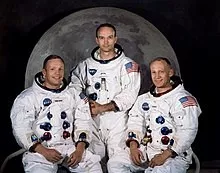Jul 21, 2018
Image: Three astronauts in spacesuits without helmets sitting in front of a large photo of the Moon. L to R: Neil Armstrong, Michael Collins, Buzz Aldrin NASA/Wikipedia
Apollo program
Apollo 11 was the spaceflight that landed the first two humans on the Moon according to Wikipedia. Mission commander Neil Armstrong and pilot Buzz Aldrin, both American, landed the lunar module Eagle on July 20, 1969, at 20:18 UTC. Armstrong became the first human to step onto the lunar surface six hours after landing on July 21 at 02:56:15 UTC; Aldrin joined him about 20 minutes later. They spent about two and a quarter hours together outside the spacecraft, and collected 47.5 pounds (21.5 kg) of lunar material to bring back to Earth. Michael Collins piloted the command module Columbia alone in lunar orbit while they were on the Moon's surface. Armstrong and Aldrin spent 21.5 hours on the lunar surface before rejoining Columbia in lunar orbit.
Apollo 11 was launched by a Saturn V rocket from Kennedy Space Center on Merritt Island, Florida, on July 16 at 9:32 am EDT (13:32 UTC) and was the fifth manned mission of NASA's Apollo program. The Apollo spacecraft had three parts: a command module (CM) with a cabin for the three astronauts, and the only part that returned to Earth; a service module (SM), which supported the command module with propulsion, electrical power, oxygen, and water; and a lunar module (LM) that had two stages – a descent stage for landing on the Moon, and an ascent stage to place the astronauts back into lunar orbit.
After being sent to the Moon by the Saturn V's third stage, the astronauts separated the spacecraft from it and traveled for three days until they entered into lunar orbit. Armstrong and Aldrin then moved into the lunar module Eagle and landed in the Sea of Tranquility. The astronauts used Eagle's upper stage to lift off from the lunar surface and rejoin Collins in the command module. They jettisoned Eagle before they performed the maneuvers that blasted them out of lunar orbit on a trajectory back to Earth. They returned to Earth and splashed down in the Pacific Ocean on July 24 after more than eight days in space.
The landing was broadcast on live TV to a worldwide audience. Armstrong stepped onto the lunar surface and described the event as "one small step for [a] man, one giant leap for mankind." Apollo 11 effectively ended the Space Race and fulfilled a national goal proposed in 1961 by U.S. President John F. Kennedy: "before this decade is out, of landing a man on the Moon and returning him safely to the Earth."
Framework
Crew
Position Astronaut
Commander Neil A. Armstrong
Second spaceflight
Command Module Pilot Michael Collins
Second spaceflight
Lunar Module Pilot Edwin "Buzz" E. Aldrin, Jr.
Second spaceflight
The crew assignment of Neil Armstrong as Commander, Jim Lovell as Command Module Pilot (CMP) and Buzz Aldrin as Lunar Module Pilot (LMP) was officially announced on November 20, 1967. Apollo 11 was the second all-veteran multi-person crew on an American mission, the first being that of Apollo 10. An all-veteran crew would not be flown again until STS-26 in 1988. Lovell and Aldrin had previously flown together as the crew of Gemini 12. The crew was initially assigned as the backup for Apollo 9. Due to design and manufacturing delays in the Lunar Module (LM), Apollo 8 and Apollo 9 swapped prime and backup crews, and Armstrong's crew became the backup for Apollo 8. Based on the normal crew rotation scheme, Armstrong was then expected to command Apollo 11. There would be one change. Mike Collins on the Apollo 8 crew began experiencing trouble with his legs. Doctors diagnosed the problem as a bony growth between his fifth and sixth vertebrae, requiring surgery. Lovell took his place on the Apollo 8 crew, and, when he recovered, Collins joined Armstrong's crew as CMP. In the meantime, Fred Haise filled in as backup LMP, and Aldrin as backup CMP for Apollo 8.
Backup crew
Position Astronaut
Commander James A. Lovell, Jr.
Command Module Pilot William A. Anders
Lunar Module Pilot Fred W. Haise, Jr.
The backup crew consisted of Lovell as Commander, William Anders as CMP, and Haise as LMP. Anders had flown with Lovell on Apollo 8. In early 1969, he accepted a job with the National Space Council effective August 1969 and announced that he would retire as an astronaut on that date. At that point Ken Mattingly was moved from the support crew into parallel training with Anders as backup CMP in case Apollo 11 was delayed past its intended July launch, at which point Anders would be unavailable. Lovell, Haise, and Mattingly would ultimately be assigned as the prime crew of Apollo 13.
Support crew
Charlie Duke, Capsule Communicator (CAPCOM)
Ronald Evans (CAPCOM)
Owen K. Garriott (CAPCOM)
Don L. Lind (CAPCOM)
Ken Mattingly (CAPCOM)
Bruce McCandless II (CAPCOM)
Harrison Schmitt (CAPCOM)
Bill Pogue
Jack Swigert
William Carpentier (SURGEON)
Flight directors
Clifford E. Charlesworth (Green Team), launch and EVA
Gerald D. Griffin (Gold Team)
Gene Kranz (White Team), lunar landing
Glynn Lunney (Black Team), lunar ascent
Call signs
Apollo 11 Command/Service Module Columbia in lunar orbit, photographed from the Lunar Module Eagle
After the crew of Apollo 10 named their spacecraft Charlie Brown and Snoopy, assistant manager for public affairs Julian Scheer wrote to Manned Spacecraft Center director George M. Low to suggest the Apollo 11 crew be less flippant in naming their craft. During early mission planning, the names Snowcone and Haystack were used and put in the news release.
The Command Module was named Columbia after the Columbiad, the giant cannon shell "spacecraft" fired by a giant cannon (also from Florida) in Jules Verne's 1865 novel From the Earth to the Moon. It also referenced Columbia, a personification of the United States. The Lunar Module was named Eagle for the national bird of the United States, the bald eagle, which was featured prominently on the mission insignia
Insignia
 Apollo 11 patch - NASA/Wikipedia
Apollo 11 patch - NASA/Wikipedia
The Apollo 11 mission insignia was designed by Collins, who wanted a symbol for "peaceful lunar landing by the United States". At Lovell's suggestion, he chose an eagle as the symbol, put an olive branch in its beak, and drew a lunar background with the Earth in the distance. The sunlight in the image was coming from the wrong direction; the shadow should have been in the lower part of the Earth instead of the left. NASA officials felt that the talons of the eagle looked too "warlike" and after some discussion, the olive branch was moved to the claws. Armstrong was concerned that "eleven" would not be understood by non-English speakers, so they went with "Apollo 11"; they decided not to put their names on the patch, so it would "be representative of everyone who had worked toward a lunar landing". All colors are natural, with blue and gold borders around the patch.
When the Eisenhower dollar coin was released in 1971, the patch design provided the eagle for its reverse side. The design was also used for the smaller Susan B. Anthony dollar unveiled in 1979, ten years after the Apollo 11 mission.
Mementos
 Apollo 11 space-flown silver Robbins Medallion - NASA/Wikipedia
Apollo 11 space-flown silver Robbins Medallion - NASA/Wikipedia
Neil Armstrong's personal preference kit carried a piece of wood from the Wright brothers' 1903 airplane's left propeller and a piece of fabric from its wing, along with a diamond-studded astronaut pin originally given to Deke Slayton by the widows of the Apollo 1 crew. This pin had been intended to be flown on Apollo 1 and given to Slayton after the mission but following the disastrous launch pad fire and subsequent funerals, the widows gave the pin to Slayton and Armstrong took it on Apollo 11.
Share this article with friends!
Tags:
#nasa,#apollo#11,#space,#starzpsychics.com,#starz#advisors



